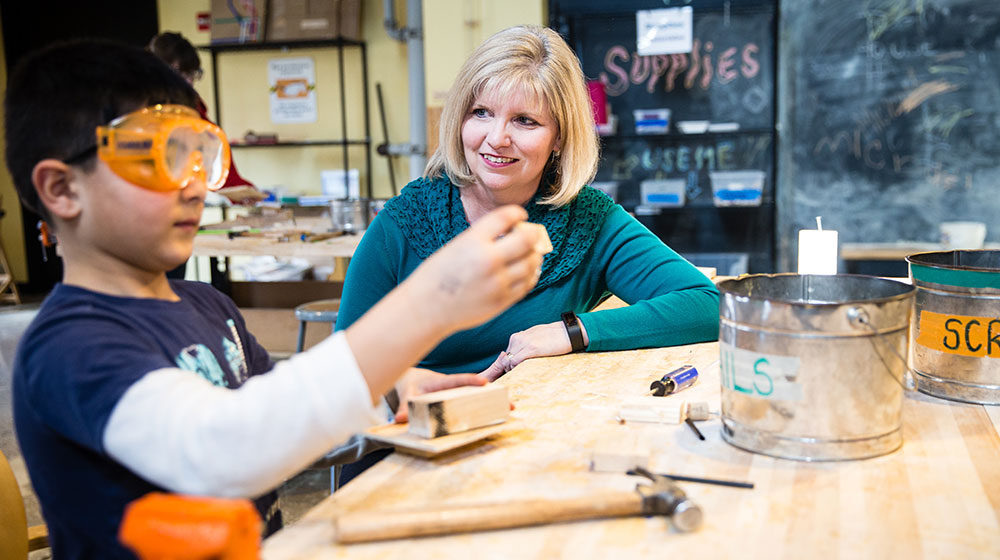More than child’s play
More than child’s play

Psychology professor Catherine Haden, PhD, watches 7-year-old Alex Amstead play at the Chicago Children’s Museum. Haden and fellow Loyola professor Perla Gámez, PhD, are studying how children learn and develop an interest in the STEM fields. (Photo: Natalie Battaglia)
By Anna Gaynor
Two Loyola researchers are trying to uncover the next big advancement in child development—and it might just be the wheel.
Or rather, the introduction of wheels.
Loyola psychology professors Catherine Haden, PhD, and Perla Gámez, PhD, recently received a nearly $740,000 grant from the National Science Foundation to better understand how children learn and develop an interest in the STEM fields. Their study will observe how children interact with the tools and supplies in the Tinkering Lab at the Chicago Children’s Museum.
“One of the challenges in these kinds of spaces is people think that tinkering is going to lead to science learning, but it can’t just be by magic,” said Haden, the director of the Children’s Memory and Learning Lab at Loyola and principal investigator of the Tinkering and Reflection Project. “The goal should be to create an environment where children will engage in more scientific practices with their parents—like trying out ideas, testing and retesting, and modifying a design when it doesn’t do exactly what you planned. And for the young children we study, parents can play a big role in learning those concepts.”
A new take on tinkering
The Tinkering Lab at Navy Pier is a workshop filled with cloth, paper, and wood as well as hammers, screwdrivers, and other tools. It encourages children from diverse family backgrounds to get their hands dirty with the scientific process, from imagining their own experiment to manipulating their creations.
Sometimes children will try to recreate what they’ve seen at different exhibits in the Children’s Museum, and many of them will make something that resembles more of an art project than a scientific one.
That’s where the wheels come in.
When the study begins this summer with hundreds of 6- to 8-year-olds and their parents, Gámez and Haden are hoping the introduction of wheels might inspire young visitors to build their own racer or a different open-ended project that gives them practice in science and engineering.
Wheels are just one idea, though.
“The grant is to observe the practices that are already happening, things that children and parents would already be trying to do, and ask, ‘How do we improve upon them?’ ” Haden said. “Then once we see things that are working, we feed it back to our partners at the museum and say, ‘I wonder if we do this and this, would it increase the amount of science talk we’re seeing in the space?’ ”
Learning by observing
A large part of Haden and Gámez’s research is observational: Watching what kinds of questions parents ask, how children interact with the objects around them, and how visiting the museum affects children long after the visit.
The study will be done in partnership with David Uttal, a professor from Northwestern University, and Tsivia Cohen from the Chicago Children’s Museum, who both received additional funds from the National Science Foundation. Working so closely with the museum gives Haden and Gámez the opportunity to share their findings with the people who could most benefit from it—educators and parents.
“Parents play a very important role in their children’s early introductions to science and engineering—all through school when they bring those homework or science projects home,” Haden said. “We’re trying to find ways to support parents as their children’s early teachers and advocates.”


